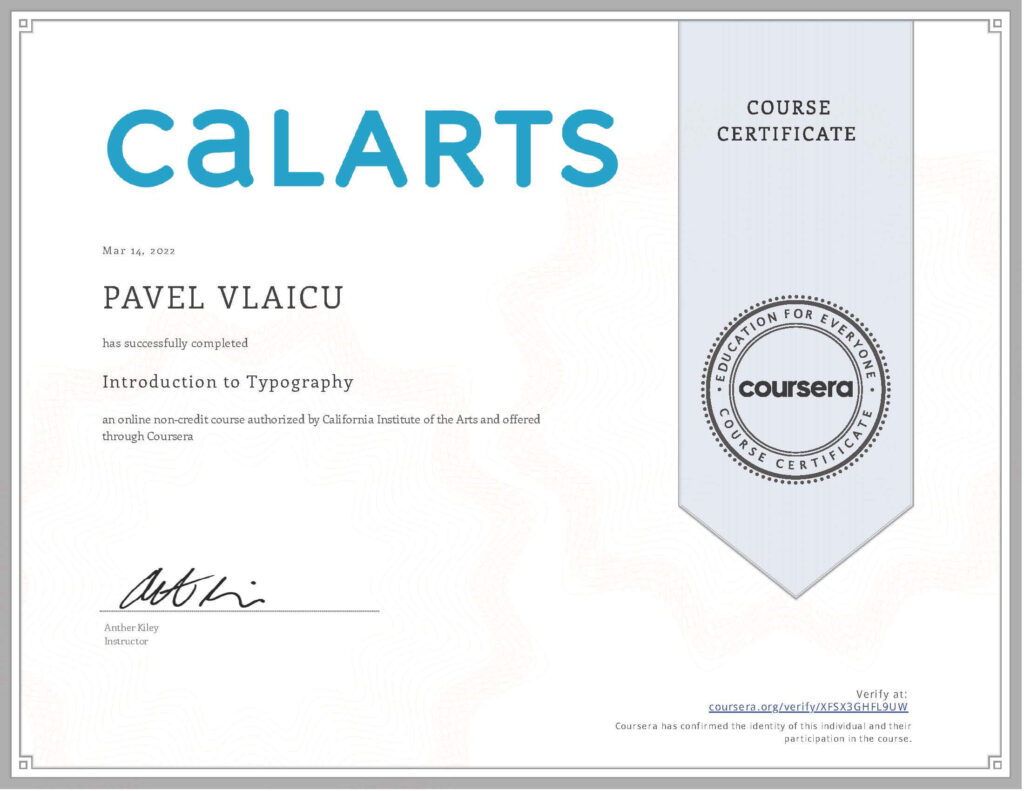About this Course
Typography is the art of manipulating the visual form of language to enrich and control its meaning. It’s an essential area of skill and knowledge for graphic designers. Typography predates modern graphic design by around 500 years; it is rich in rules, conventions, and esoteric terminology—but it remains an exciting space for invention and expression.
In this rigorous introductory course, we will study, name, and measure the characteristics of letterforms. We’ll consider the pragmatic concerns involved in selecting and combining type. We’ll peek into the rich historical, cultural, and aesthetic histories of familiar typefaces. We’ll discuss time-tested conventions and best practices in setting type, as governed by principles of hierarchy and spatial organization. And we’ll explore the expressive, meaning-making potential of type.
Informative lectures will be complemented by a series of three peer-assessed assignments, culminating in an opportunity to design a full-scale typographic poster.
Please note that this is not a software course; a basic working knowledge of Adobe InDesign or other page layout software will be assumed. You will need access to a computer and page layout software, such as InDesign, to complete the assignments.
What you will learn
Review the terminology and measuring system used to describe type
Explore how typefaces tell stories and understand the historic evolution
Conduct a peer-reviewed typesetting exercise
Design of a full-scale typographic poster
Skills you will gain
Creativity
Adobe Illustrator
History
Graphics
Adobe Indesign
Instructor
Anther Kiley
Instructor
Offered by
California Institute of the Arts
CalArts has earned an international reputation as the leading college of the visual and performing arts in the United States. Offering rigorous undergraduate and graduate degree programs through six schools—Art, Critical Studies, Dance, Film/Video, Music, and Theater—CalArts has championed creative excellence, critical reflection, and the development of new forms and expressions.
Syllabus – What you will learn from this course
Week 1
Week 1: Talking Type
This week, we’ll take an up-close look at typefaces, both as physical artifacts and as works of design. We will study the formal elements that define and give character to type and understand where they came from and why they look the way they do. We will review the terminology and measuring system used to describe type and look at the way the form and proportion of letters relate to the practical concerns of selecting and combining typefaces. The week will wrap up with a graded quiz.
Week 2
Week 2: Typefaces and their Stories
This week, we’ll explore the way typefaces express connotative meaning—tell stories—through their association with different time periods, aesthetics, and ideas. Through six short case studies, we will look at the way a typeface’s connotations are shaped by its context, understand the historic evolution of typographic forms, and familiarize ourselves with the way typefaces are classified. You’ll extend your exploration through some independent research into a typeface of your choosing.
Week 3
Week 3: Putting Type to Work
This week, we will engage the visual principles and conventions of typesetting. We will look at how the spaces between letters, lines, and blocks of type can be manipulated to refine the appearance and control the meaning of type. We’ll explore the ways typographic hierarchy and grid systems can further organize and clarify type. And we’ll survey the rules and conventions that can add polish to your typesetting. You’ll apply your skills and knowledge in a peer-reviewed typesetting exercise at the end of the week.
Week 4
Week 4: Making Meaningful Type
In our final week, we’ll examine the ways typographic form can dramatically shape the meaning of written language. We’ll survey and analyze possibilities for type treatments—from subtle typesetting choices to dramatic manipulations—by looking at examples of expressive and unconventional typography. At the end of the week, you’ll bring together and apply everything you have learned in this course in the design of a full-scale typographic poster.

